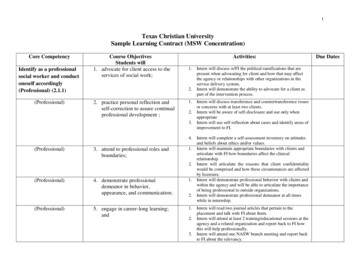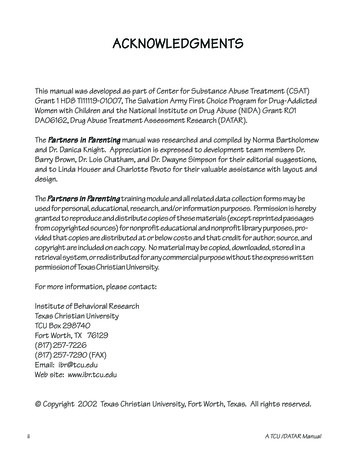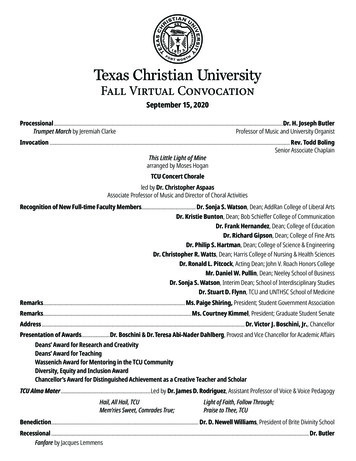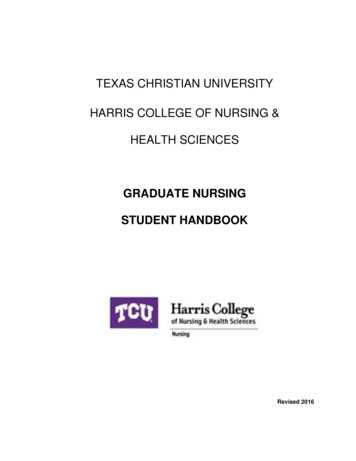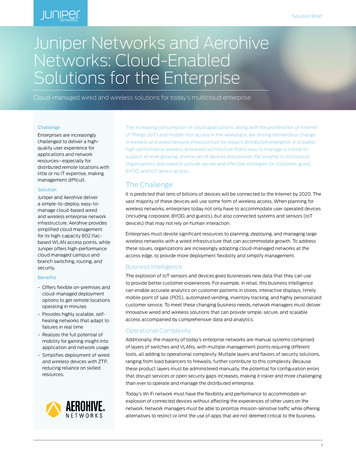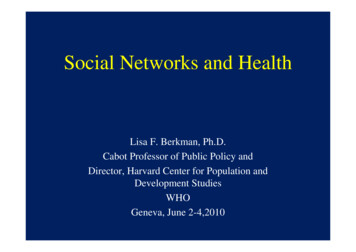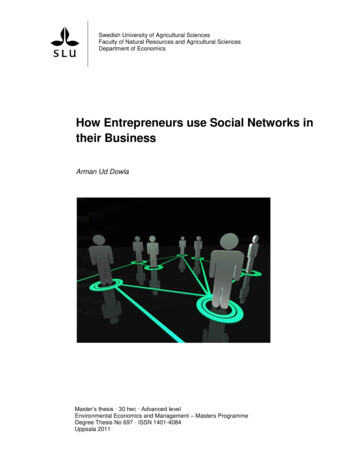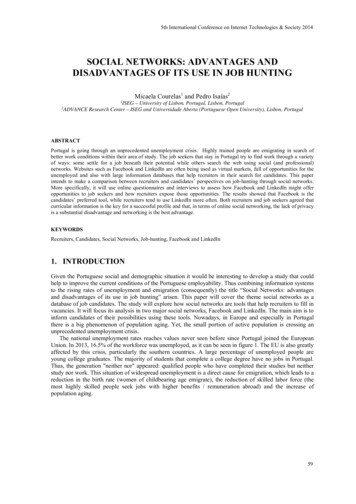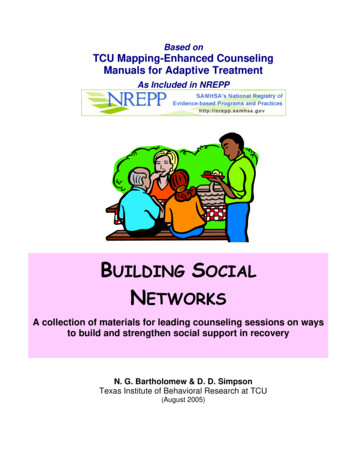
Transcription
Based onTCU Mapping-Enhanced CounselingManuals for Adaptive TreatmentAs Included in NREPPBUILDING SOCIALNETWORKSA collection of materials for leading counseling sessions on waysto build and strengthen social support in recoveryN. G. Bartholomew & D. D. SimpsonTexas Institute of Behavioral Research at TCU(August 2005)
TCU Mapping-Enhanced Counseling manuals provide evidence-basedguides for adaptive treatment services (included in National Registry ofEvidence-based Programs and Practices, NREPP, 2008). They are derivedfrom cognitive-behavioral models designed particularly for counselors andgroup facilitators working in substance abuse treatment programs.Although best suited for group work, the concepts and exercises can bedirectly adapted to individual settings.When accompanied by user-friendly information about client assessmentsthat measure risks, needs, and progress over time, TCU MappingEnhanced Counseling manuals represent focused, time-limited strategiesfor engaging clients in discussions and activities on important recoverytopics. These materials and related scientific reports are available asAdobe PDF files for free download at http://www.ibr.tcu.edu. Copyright 2005 Texas Institute of Behavioral Research at TCU, Fort Worth,Texas 76129. All rights reserved. Permission is hereby granted to reproduceand distribute copies of this manual (except reprinted passages fromcopyrighted sources) for nonprofit educational and nonprofit library purposes,provided that copies are distributed at or below costs and that credit forauthors, source, and copyright are included on each copy. No material may becopied, downloaded, stored in a retrieval system, or redistributed for anycommercial purpose without the expressed written permission of TexasChristian University.Texas Institute of Behavioral ResearchiiTCU ( 2005)
TCU MAPPING-ENHANCED COUNSELING MANUALSFOR ADAPTIVE TREATMENTBUILDING SOCIAL NETWORKSTable of ContentsPart 1: Social Networks in Recovery . 1Description: Leader guide for group with topic notes, worksheets, handouts,and discussion questionsSource: TCU / Institute of Behavioral Research. From treatment manualStraight Ahead: Transition Skills for Recovery http://www.ibr.tcu.eduPart 2: Support Groups and Your Recovery. 8Description: Leader guide for group with topic notes, worksheets, handouts,and discussion questionsSource: TCU / Institute of Behavioral Research. From treatment manualStraight Ahead: Transition Skills for Recovery http://www.ibr.tcu.eduPart 3: When Other Family Members Use . 17Description: Discussion activity for group with worksheets and handoutSource: UCLA / Matrix Institute/NDRI/Neurobehavioral TreatmentMatrix Institute: http://www.matrixinstitute.orgPart 4: Mapping Worksheets . 21Description: A set of activity worksheets for use in group discussions orindividual counselingSource: TCU / Institute of Behavioral Research. From treatment manual TCUGuide Maps: A Resource for Counselors http://www.ibr.tcu.eduLinks of Interest . 33Description: Links to Web sites on strengthening relationships Copyright 2004; 2005 TCU Institute of Behavioral Research, Fort Worth, Texas. All rights reserved.Texas Institute of Behavioral ResearchiiiTCU ( 2005)
Part 1:Social Networks inRecoverySocial Networks in Recovery is part of the Straight Ahead:Transition Skills for Recovery manual developed at TCU. Thissession features a leader’s script, with notes, worksheets, andhandouts for leading a solution-focused or strengths-baseddiscussion of choosing a supportive network of friends. Participantsare invited to think about what qualities they look for in friends whowill help them stay true to their recovery goals. Materials for a“mini-lecture” highlight considerations for a strong network.Source: TCU / Institute of Behavioral Research. From treatment manualStraight Ahead: Transition Skills for RecoveryTexas Institute of Behavioral Research1TCU ( 2005)
Social Networks in RecoveryStep 1Introduce the topic of social networks and recovery:The “experts” who study drug addiction and recovery have long been interested in aspecial group of recovering people who seem to have stuck to their decisions to quitusing without formal treatment. This phenomenon is often referred to as “naturalrecovery.” When interviewed, these natural recoverers frequently mention thechanges they made in their social networks as a big part of their recovery process.These changes included making new friends and acquaintances who didn’t use drugsas well as developing strategies for dealing with old friends and family memberswho still used. In many cases, natural recoverers opted to discontinue theirassociations with users, or at least limit the time they spent with them.As you continue to make progress in your recovery you may find it helpful to givesome thought to the people you include in your social network. For example,natural recoverers have noted that they found it very difficult to continuefriendships that were centered on using drugs and “partying.” These associationswere found to trigger cravings. On the other hand, some natural recoverersreported being able to maintain relationships with friends who used drugs,providing the friends were willing not to use around them.The decision to include or not include people who use drugs in your social network isa personal one. The main thing is to seek out friends who encourage and supportyour recovery efforts. This session will provide you with a chance to think aboutfriendships and social networks, and to explore your own needs and goals in this area.Ask, for discussion: What is friendship?Play a popular song about friendship to help set the tone for thediscussion. You may want to provide copies of the lyrics so people canfollow the words.Suggestions:You’ve Got A Friend - James Taylor (Carole King)Stand By Me - Ben E. KingWe All Need Somebody (To Lean On) - Bill WithersThat’s What Friends Are For - Dionne WarwickWind Beneath My Wings - Bette MidlerIf I Could – Patti LaBelleTexas Institute of Behavioral Research2TCU ( 2005)
Social Networks in RecoveryLead a discussion about the nature of friendship, using the followingquestions.What does this song say to you about the nature of friendship? What dofriends contribute to your life?What are some things you do to keep your friendships with others going?Are there different kinds of friendships? Describe some of the differentkinds of friendships you have now.Let's talk about friends who have helped you with your recovery goals.What's been the most helpful thing a friend has done for you to keep you ontrack with what's good for you in recovery?What about friends who still use? How do you deal with them so that theirusing doesn't hurt your recovery? What works?Transition:One important consideration is to think seriously about the qualities or characteristics of friendsthat make them important allies in recovery. The next activity requires that you use a littleimagination in order to zero in on the qualities of friends who will support you in recovery.Step 2Distribute Starship Straight Ahead worksheets (page 7) and pencils.Tell participants you want them to take part in an exercise to exploretheir friendships, especially those friendships that help them stay strongin recovery. Explain that it is a story exercise, and encourage them tolet themselves go and follow along with it.Use the following script to lead the story:A wonderful space being from another planet has come to earth to visit you. The spacebeing is named Zando. Zando tells you about the planet he comes from, explaining thatTexas Institute of Behavioral Research3TCU ( 2005)
Social Networks in Recoveryit’s a place where you can be the person you always wanted to be and have the lifeyou’ve always dreamed of having. Zando wants to take you to his planet, and you areeager to go. So you make your plans.Here’s the deal, though. Zando tells you that there are drugs on his planet, too. Becauseof the atmosphere on his planet, the temptation to use can be very overpowering andstrong. But if you use while you are there, well, he paints a very nasty picture of whatwould happen if you used on his planet. Still, though, because of everything that he’stold you, you really want to travel with him. Because this planet offers you the chance tobe who you’ve always wanted to be and have the life you’ve always wanted. Zandoassures you that after a while on his planet, the temptation to use drugs gets very weakand faint, and after a while it won’t trouble you any more.In order to make it easier for you, Zando tells you that you can choose three (3) friends oradult family members to travel with you. He tells you that you should choose the threepeople who help you the most in your recovery. In other words, the people who supportyou, encourage you, and give you strength to not use.Think about it for a minute. Then write the names of the three people you would choosewhere it says “Support Crew.”Stop the story here, ask some of the following questions and brieflydiscuss them before continuing:How was it to pick your crew? Easy or more difficult? Why?How did you decide who would be your support crew?What personal qualities did you look for?What does each member of your support crew do to encourage your recovery?Continue story:The day arrives. You, your support crew, and Zando take off to the wonderful planetwhere you can be happy and live the life you dream of. But wait!! Suddenly, there’s aproblem with the spaceship. Zando tells you that the ship is overloaded, and that inorder to make it, you will have to send one of your support crew back to earth in aTexas Institute of Behavioral Research4TCU ( 2005)
Social Networks in Recoveryspecial space pod. There’s no danger, but it must be done. Repeat: there is no danger tothe person who must be sent back. In fact, it will be fun and he or she will beinterviewed by Diane Sawyer upon landing. Zando advises you to ask the two peoplewho are most supportive of your recovery to stay with you.Think about it for a minute, then decide who you will send back to earth in the spacepod. Draw a Space Pod on your worksheet and write the name of the person you willsend home inside of it. Cross that name off you support crew list.Stop the story again, ask and briefly discuss some of the followingquestions before resuming:How was it to make this choice? Easy or difficult? Why?How did you feel about making the choice?What factors related to your recovery influenced your choice of who to sendback to earth?Continue story:Your journey with Zando continues toward the wonderful planet where you can live the lifeyou’ve always wanted to lead, as long as you don’t use. As you near the planet, you beginto feel some cravings. Zando tells you this will pass, and besides, you have your supportcrew to help you out when you need them.But wait! Zando gets a radio transmission. He’s informed that new regulations will onlyallow three passengers to land on the planet at one time. Zando tells you that you must sendanother member of your support crew back to earth in a space pod. Again there’s nodanger, but you must decide who to send back. Zando advises you that you will really needa strong support person when you land—so choose wisely.Who will you send back this time? Write the name inside the Space Pod. Remove thatname from your crew list.Texas Institute of Behavioral Research5TCU ( 2005)
Social Networks in RecoveryStop the story, and lead a discussion using some of followingquestions:Was it difficult to make this choice? What made it difficult or easy for you?How did you feel about having to make this choice?Why did you keep this person? How is he/she most helpful to your recovery?If you begin having strong urges to use, how will you ask your support person forhelp? What will you say? When will be the best time to ask for support?When you’re having a bad day, what’s the most important thing a support personcan do for you? What is it you need most from your friends?When you turn to a friend with a problem, what does he/she do that is reallyhelpful? And what does he/she do sometimes that is not helpful? What’s the bestway to tell a friend that he/she has helped you? How about when a friend is notbeing helpful—what’s the best way to tell him/her?Step 3Summarize the discussion:Zando’s planet could really be earth. It holds the opportunity for us to be happy and livelife to the fullest. The purpose of this exercise was to help focus attention on the part oursocial network (our friends, family, and acquaintances) plays in our recovery efforts. Thechoices you made during the exercise can help you explore the qualities you value in yourreal-life, earth-bound support crew for recovery. You are the best person to decide on thepeople who help you most, those you can count on, and those who you can trust.Friends serve a different need for each person. A supportive friend or group of friends canhelp recovery efforts, if nothing else by simply giving you someone to talk with about yourproblems. Ultimately, you are responsible for your own recovery. And supportive friendscan help keep you in touch with that reality in a caring, nonjudgmental way.Thank participants for their input.Texas Institute of Behavioral Research6TCU ( 2005)
Social Networks in RecoveryTexas Institute of Behavioral Research7TCU ( 2005)
Part 2:Support Groupsand Your RecoverySupport Groups and Your Recovery is part of the Straight Ahead:Transition Skills for Recovery manual developed at TCU. Thissession features a leader’s script, with notes, worksheets, andhandouts for leading an open discussion of deciding on and joininga recovery-centered support group. Participants are invited tochallenge myths about 12-Step groups and to think about what theyneed from a support group and what they have to offer to others.Materials for a “mini-lecture” highlight strategies for finding theright group, asking for sponsorship, and checking out alternativegroups.Source: TCU / Institute of Behavioral Research. From treatment manualStraight Ahead: Transition Skills for RecoveryTexas Institute of Behavioral Research8TCU ( 2005)
Support Groups and Your RecoveryStep 1Introduce the topic of finding and utilizing a support group:There are hundreds of different kinds of support groups meeting each day in thiscountry. They’re called support groups because the members offer help and support toeach other based on personal experiences, rather than on medical or psychologicaltheories. “I know what you’re going through ‘cause I’ve been there myself,” is theguiding philosophy of most support groups.AA, NA, and CA are the most widely known groups, with daily meetings available inmost areas. As you’re probably aware, these groups are for people who want to quitusing drugs or alcohol. The meetings are free and open to anyone, and they follow ageneral philosophy known as The Twelve Steps. These groups provide encouragementand support from people who have “been there,” and they’re often a good place tomeet new friends who have quit using and are serious about recovery.Support groups have a lot to offer, and thousands of recovering people have benefitedfrom joining a group. Membership in a support group can:Help you deal with urges to use or drinkProvide support and understanding when setbacks occurGive you a place to share and hear success storiesHelp fill your spare timeIntroduce you to new people and new ideasAsk and briefly discuss some of the following questions.Who has attended 12-Step meetings? How many of you are still attending?What are the benefits of attending AA or NA? How do these groups help people?What other types of support groups (other than 12-step) are you familiar with?Transition:Today’s session is a chance for you to consider (or reconsider) getting involved in asupport group in your community. An important consideration is what you, as anTexas Institute of Behavioral Research9TCU ( 2005)
Support Groups and Your Recoveryindividual, need and want from group membership. Another is what you, with allyou’ve learned and been through on the road to recovery, can offer to others.Step 2Distribute Support Group Interview worksheets (page 15) andpencils. Instruct participants to team up with a partner and take turnsinterviewing each other, using the questions on the worksheets. In otherwords, Person A should ask Person B the questions on their worksheetand record the answers. Then Person B will ask Person A the questionson their worksheet and record the answers. Allow 10-15 minutes forcompletion. Prompt partners to switch at halfway point.Ask, and briefly discuss participants’ ideas from the interviewexercise using some of the following questions:How did it feel to do this exercise? Was it easy or difficult?How did it feel to discuss your ideas about support groups with anotherrecovering person (e.g. your partner in the exercise)?What benefits of having a support group did this exercise help you identify?How would members of a support group benefit from the lessons you’ve learnedin life? What would you be able to contribute to others in the group?(For those who have a group: What benefits do you bring to your group?)Transition:For many people in recovery, finding a support group is a “win-win” situation. A good homegroup becomes a place to get encouragement and support, as well as a place to offerencouragement and support to others. Getting involved often requires some thought and someresearch in order to find the “right” group for you.Texas Institute of Behavioral Research10TCU ( 2005)
Support Groups and Your RecoveryStep 3Distribute Getting Involved handout (page 16), and use it to lead adiscussion about community resources for support. Encourageparticipants to use the “Good Ideas” area on the handout to jot downhelpful ideas brought up during the discussion. Suggested discussionquestions are included for each point on the handout.Point 1Shop around until you find one or more AA or NA meetings whereyou feel comfortable.It may take a little “detective” work to find the meeting you like best. Especially in largercommunities, there are a number of meeting locations, meeting styles (e.g.,non-smokers,women-only or men-only), and meeting times to choose from. A general recommendation isto visit meetings before committing to one. If you feel right at home—great! If not, consideranother location or time.What will help you determine if a certain group is right for you?When will be the best time of day for you to attend meetings?Who would be a good person to go with you when you “shoparound” for a group you like?Point 2If you’re dealing with a partner or family member who uses,consider attending Al-Anon meetings as well.These groups help you learn not to take responsibility for someone else’s alcohol or drugproblem. They are also helpful to recommend to your family members or friends who mayneed some support in helping you stay on track with your recovery.Texas Institute of Behavioral Research11TCU ( 2005)
Support Group and Your RecoveryHow can you find out if an Al-Anon group would be helpful for you?What would you expect to get out of an Al-Anon group?Who in your family or support group might benefit from Al-Anon?Point 3Attend meetings regularly. If things are going rough, considerattending every day.The best way to get support from a group is by being there. If you’re having a rough spell ordealing with difficult cravings, attending a meeting is one way to help you get through it. It’snot unusual at 12-Step meetings to hear someone at the back of the room say “I don’t reallywant to talk tonight. I just needed to be here.” That’s the spirit of what meetings are for.What steps will you need to take in order to attend a weekly meeting?How will you carry out these steps?What are some “warning signs” that
Social Networks in Recovery is part of the Straight Ahead: Transition Skills for Recovery manual developed at TCU. This session features a leader’s script, with notes, worksheets, and handouts for l

